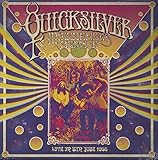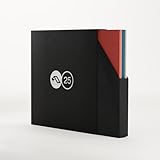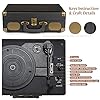Quicksilver Messenger Service Vinyl Records Lps For Sale
Check out these new and used Quicksilver Messenger Service vinyl records LPs for sale. We recommend starting your Quicksilver Messenger Service vinyl collection with the essential albums Happy Trails, Shady Grove and Just For Love. Our inventory is always changing, so check back often, or browse our list of vinyl records for sale from rock musicians.
Quicksilver Messenger Service
Happy Trails
$32.96 (as of July 3, 2025 08:27 GMT +00:00 - More infoProduct prices and availability are accurate as of the date/time indicated and are subject to change. Any price and availability information displayed on [relevant Amazon Site(s), as applicable] at the time of purchase will apply to the purchase of this product.)Live At The Winterland Ballroom - December 1, 1973
$61.66 (as of July 3, 2025 08:29 GMT +00:00 - More infoProduct prices and availability are accurate as of the date/time indicated and are subject to change. Any price and availability information displayed on [relevant Amazon Site(s), as applicable] at the time of purchase will apply to the purchase of this product.)Quicksilver
$40.00 (as of July 3, 2025 08:29 GMT +00:00 - More infoProduct prices and availability are accurate as of the date/time indicated and are subject to change. Any price and availability information displayed on [relevant Amazon Site(s), as applicable] at the time of purchase will apply to the purchase of this product.)Rare Tracks - Purple Marble
$17.98 (as of July 3, 2025 08:29 GMT +00:00 - More infoProduct prices and availability are accurate as of the date/time indicated and are subject to change. Any price and availability information displayed on [relevant Amazon Site(s), as applicable] at the time of purchase will apply to the purchase of this product.)Quicksilver Messenger Service - Anthology - Lp Vinyl Record
$20.95 (as of July 3, 2025 08:29 GMT +00:00 - More infoProduct prices and availability are accurate as of the date/time indicated and are subject to change. Any price and availability information displayed on [relevant Amazon Site(s), as applicable] at the time of purchase will apply to the purchase of this product.)Live in San Jose - September 1966
$24.98 (as of July 3, 2025 08:27 GMT +00:00 - More infoProduct prices and availability are accurate as of the date/time indicated and are subject to change. Any price and availability information displayed on [relevant Amazon Site(s), as applicable] at the time of purchase will apply to the purchase of this product.)Shady Grove
$29.98 (as of July 3, 2025 08:35 GMT +00:00 - More infoProduct prices and availability are accurate as of the date/time indicated and are subject to change. Any price and availability information displayed on [relevant Amazon Site(s), as applicable] at the time of purchase will apply to the purchase of this product.)Quicksilver Messenger Service - Happy Trails [LP]
$49.99 (as of July 3, 2025 08:35 GMT +00:00 - More infoProduct prices and availability are accurate as of the date/time indicated and are subject to change. Any price and availability information displayed on [relevant Amazon Site(s), as applicable] at the time of purchase will apply to the purchase of this product.)Quicksilver Messenger Service – Just For Love Capitol – SMAS-498, SMAS-80498, SMAS-8-0498 Format: Vinyl, LP, Album, Club Edition, Gatefold US 1970 Genre: Psychedelic Rock VG+/VG++
$14.95 (as of July 3, 2025 08:27 GMT +00:00 - More infoProduct prices and availability are accurate as of the date/time indicated and are subject to change. Any price and availability information displayed on [relevant Amazon Site(s), as applicable] at the time of purchase will apply to the purchase of this product.)
Quicksilver Messenger Service: Exploring the Psychedelic Pioneers
Early Days and Formation
Quicksilver Messenger Service, often abbreviated as QMS, emerged during the vibrant era of the 1960s, a time when the counterculture movement was at its peak. The band originated in San Francisco, California, and was a crucial part of the city’s burgeoning psychedelic rock scene. Formed in 1965, the group underwent several lineup changes throughout its existence, but its core members included Dino Valenti, Gary Duncan, John Cipollina, Greg Elmore, and David Freiberg.
Psychedelic Sound and Experimentalism
Quicksilver Messenger Service quickly gained a reputation for their distinctive sound, characterized by extended instrumental improvisations, intricate guitar work, and a blend of blues, folk, and rock influences. Their music often delved into experimental territory, incorporating elements of jazz and avant-garde, setting them apart from their contemporaries.
Notable Albums
1. Quicksilver Messenger Service (1968)
The band’s self-titled debut album, released in 1968, showcased their prowess in creating a unique sonic experience. Tracks like “Pride of Man” and “Dino’s Song” demonstrated the fusion of folk and rock elements, while the instrumental “Gold and Silver” highlighted the band’s improvisational skills. The album received critical acclaim and laid the foundation for Quicksilver Messenger Service’s place in the psychedelic rock pantheon.
2. Happy Trails (1969)
Widely considered one of their masterpieces, “Happy Trails” was a live album that captured the raw energy of Quicksilver Messenger Service’s performances. The album’s standout track, a 25-minute rendition of Bo Diddley’s “Who Do You Love,” exemplified the band’s improvisational prowess. “Happy Trails” solidified their reputation as one of the premier live acts of the era.
3. Shady Grove (1969)
“Shady Grove” marked a departure from their previous works, incorporating acoustic elements and folk influences more prominently. The title track and “3 or 4 Feet from Home” showcased the band’s versatility, revealing a softer, more melodic side. Despite being less commercially successful than their previous releases, “Shady Grove” earned praise for its musical diversity.
Influences and Contemporaries
Quicksilver Messenger Service was part of a vibrant music scene in San Francisco that included other iconic bands of the era. The Haight-Ashbury district became a hub for the counterculture movement, and QMS shared stages with bands like Jefferson Airplane, Grateful Dead, and Big Brother and the Holding Company.
1. Jefferson Airplane
As pioneers of the psychedelic sound, Jefferson Airplane shared a similar trajectory with Quicksilver Messenger Service. Both bands were integral to the San Francisco scene, and their experimentation with unconventional structures and sounds contributed to the evolution of psychedelic rock.
2. Grateful Dead
The Grateful Dead and Quicksilver Messenger Service often found themselves mentioned in the same breath. Both bands were known for their improvisational live performances, and their paths frequently crossed during the heyday of the psychedelic movement.
3. Big Brother and the Holding Company
Led by the charismatic Janis Joplin, Big Brother and the Holding Company were contemporaries of Quicksilver Messenger Service. Their bluesy, raw energy paralleled QMS’s experimental approach, creating a dynamic and influential period in the history of rock music.
Legacy and Influence
Quicksilver Messenger Service’s influence extended beyond their contemporaries, shaping the future of rock music in various ways. The band’s innovative sound and experimental approach left an indelible mark on subsequent generations of musicians.
1. New Riders of the Purple Sage
Emerging in the early 1970s, the New Riders of the Purple Sage incorporated elements of country and rock, drawing inspiration from Quicksilver Messenger Service’s fusion of genres. The band’s emphasis on improvisation and diverse musical influences reflected the impact of QMS.
2. Gov’t Mule
Gov’t Mule, formed in the ’90s by Allman Brothers Band guitarist Warren Haynes, showcased a musical style deeply rooted in blues and rock. Quicksilver Messenger Service’s legacy of blending genres and pushing musical boundaries can be heard in Gov’t Mule’s expansive sound.
3. The Black Crowes
The Black Crowes, known for their revival of classic rock aesthetics in the ’90s, drew inspiration from the free-spirited ethos of Quicksilver Messenger Service. The band’s incorporation of blues, soul, and rock resonated with the eclectic spirit that defined QMS’s music.
Final Notes
Quicksilver Messenger Service’s journey through the psychedelic landscape of the 1960s and early ’70s left an enduring legacy. Their commitment to pushing musical boundaries and creating a unique sonic experience continues to influence artists across genres. As we revisit their albums and immerse ourselves in the groundbreaking sounds of QMS, it becomes evident that their contribution to the evolution of rock music is both significant and timeless.
Quicksilver Messenger Service Self-Titled vinyl LP 1968 First Press Tested
 | $20.00 Buy It on eBay for only: $20.00 Buy It Now on eBay |
QUICKSILVER MESSENGER SERVICE – HAPPY TRAILS - VINYL LP ST120 CAPITOL VG+ - A32
 | $16.91 Buy It on eBay for only: $16.91 Buy It Now on eBay |
QUICKSILVER MESSENGER SERVICE ANTHOLOGY DOUBLE LP Classic Rock Music
 | $11.00 Buy It on eBay for only: $11.00 Buy It Now on eBay |
QUICKSILVER MESSENGER SERVICE - QUICKSILVER (original Capitol label) EX+
 | $12.00 Buy It on eBay for only: $12.00 Buy It Now on eBay |
Quicksilver Messenger Service What About Me LP Capitol 1970 Unplayed In Shrink
 | $13.99 End Date: Sunday Jul-06-2025 18:12:29 EDT Buy It on eBay for only: $13.99 Buy It Now on eBay |
QUICKSILVER MESSENGER SERVICE Quicksilver CAPITOL LP VG+ c
 | $8.50 (2 bids) End Date: Monday Jul-07-2025 12:31:51 EDT Bid |
Quicksilver Messenger Service Lp Happy Trails On Capitol - Vg+ / Vg++
 | $15.99 Buy It on eBay for only: $15.99 Buy It Now on eBay |
Quicksilver Messenger Service Comin' Thru 12" album vinyl record LP 33 RPM, EX
 | $9.99 Buy It on eBay for only: $9.99 Buy It Now on eBay |
Quicksilver Messenger Service - Live In San Jose - September 1966 (2 LP)
 | $25.95 Buy It on eBay for only: $25.95 Buy It Now on eBay |
Quicksilver Messenger Service Self-Titled Vinyl 1968 First Press Jacksonville VG
 | $10.99 Buy It on eBay for only: $10.99 Buy It Now on eBay |
Quicksilver Messenge - Quicksilver Messenger Service [New Vinyl LP]
 | $33.43 Buy It on eBay for only: $33.43 Buy It Now on eBay |
Quicksilver Messenger Service - Just for Love (VG/VG) Vinyl Record LP SMAS-498
 | $6.85 Buy It on eBay for only: $6.85 Buy It Now on eBay |
QUICKSILVER MESSENGER SERVICE ANTHOLOGY 1973 Double Vinyl 2LP Capitol SVBB-11165
 | $4.00 Buy It on eBay for only: $4.00 Buy It Now on eBay |
Quicksilver Anthology Original 1973 Double Vinyl LP Record Album VG+
 | $8.99 Buy It on eBay for only: $8.99 Buy It Now on eBay |
Quicksilver Messenger Service S/T LP Capitol ST 2904 Stereo, Original Press
 | $19.00 Buy It on eBay for only: $19.00 Buy It Now on eBay |
QUICKSILVER MESSENGER SERVICE - Happy Trails (Germany) 12" Vinyl Record LP - VG+
 | $27.99 Buy It on eBay for only: $27.99 Buy It Now on eBay |
Quicksilver Messenger Service Solid Silver 1975 Vinyl LP Record Psychedelic Rock
 | $12.00 End Date: Sunday Jul-06-2025 17:00:29 EDT Buy It on eBay for only: $12.00 Buy It Now on eBay |
QUICKSILVER MESSENGER SERVICE "Shady Grove" 1969 (CAPITOL/SM391) VG/EX!
 | $12.99 Buy It on eBay for only: $12.99 Buy It Now on eBay |
QUICKSILVER MESSENGER SERVICE SOLID SILVER CAPITOL ECS80371 Japan VINYL LP
 | $3.99 End Date: Sunday Jul-06-2025 20:45:00 EDT Buy It on eBay for only: $3.99 Buy It Now on eBay |
Quicksilver Messenger Service “Just For Love” Vinyl Record Lp
 | $9.00 Buy It on eBay for only: $9.00 Buy It Now on eBay |


























![Back to Black [Vinyl] #1](https://m.media-amazon.com/images/I/61Db7-hQGKL._SL100_.jpg)

![Legend [Vinyl] #1](https://m.media-amazon.com/images/I/611La+6Hi9L._SL100_.jpg)
![Legend [Vinyl] #2](https://m.media-amazon.com/images/I/31nfAYBov8L._SL100_.jpg)
![Legend [Vinyl] #3](https://m.media-amazon.com/images/I/21h7ykrSuuL._SL100_.jpg)
![Legend [Vinyl] #4](https://m.media-amazon.com/images/I/318kzRTVolL._SL100_.jpg)
![Legend [Vinyl] #5](https://m.media-amazon.com/images/I/31vjgY6+u5L._SL100_.jpg)




![[Exquisite Appearance] Built from wood and metal materials with a unique sense of layering; The streamlined corner design is truly atmospheric and stylish(Note: long hold the start button to turn the power on, and press again to start) [All in 1] Thi...](https://m.media-amazon.com/images/I/41vovGjFkeL._SL160_.jpg)






































